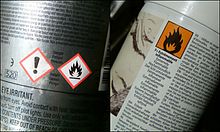
In art, in particular drawings in pastels, charcoal, chalk, and other dry media, a fixative is a kind of preserving agent applied over the top of the drawing to prevent crumbling, [1] smudging, fading, and discolouring. [2] [3] In times gone by, natural substances such as diluted egg white were painted on, but today synthetic sprays are usually used. [1] However some artists, such as the Aboriginal Australian artists at Warmun, Western Australia, use traditional substances, in this case gum gathered from local bloodwood trees. [4]
Fixative is similar to varnish, but there are some key differences. Varnish is often used to protect paintings from atmospheric moisture, sunlight and dust; it helps to protect from being scratched, and makes the colours brighter. Fixatives prevents smearing. [5]
Fixatives are usually made from casein, synthetic resin or glue. [5]
References
- ^ a b "Fixative". Oxford Reference.
- ^ "These are the best spray fixatives to stabilize your chalk and charcoal drawings". ARTnews.com. Retrieved 24 May 2022.
- ^ Caves, Julie (29 August 2014). "Fixatives are not all the same". Jackson's Art Blog. Retrieved 24 May 2022.
- ^ "Warmun Aboriginal Art & Artists". Japingka Aboriginal Art Gallery. 31 January 2022. Retrieved 24 May 2022.
- ^ a b "Varnish vs Fixative: What are Their Differences and Key Features?". Artistro. 29 August 2020. Retrieved 24 May 2022.

In art, in particular drawings in pastels, charcoal, chalk, and other dry media, a fixative is a kind of preserving agent applied over the top of the drawing to prevent crumbling, [1] smudging, fading, and discolouring. [2] [3] In times gone by, natural substances such as diluted egg white were painted on, but today synthetic sprays are usually used. [1] However some artists, such as the Aboriginal Australian artists at Warmun, Western Australia, use traditional substances, in this case gum gathered from local bloodwood trees. [4]
Fixative is similar to varnish, but there are some key differences. Varnish is often used to protect paintings from atmospheric moisture, sunlight and dust; it helps to protect from being scratched, and makes the colours brighter. Fixatives prevents smearing. [5]
Fixatives are usually made from casein, synthetic resin or glue. [5]
References
- ^ a b "Fixative". Oxford Reference.
- ^ "These are the best spray fixatives to stabilize your chalk and charcoal drawings". ARTnews.com. Retrieved 24 May 2022.
- ^ Caves, Julie (29 August 2014). "Fixatives are not all the same". Jackson's Art Blog. Retrieved 24 May 2022.
- ^ "Warmun Aboriginal Art & Artists". Japingka Aboriginal Art Gallery. 31 January 2022. Retrieved 24 May 2022.
- ^ a b "Varnish vs Fixative: What are Their Differences and Key Features?". Artistro. 29 August 2020. Retrieved 24 May 2022.